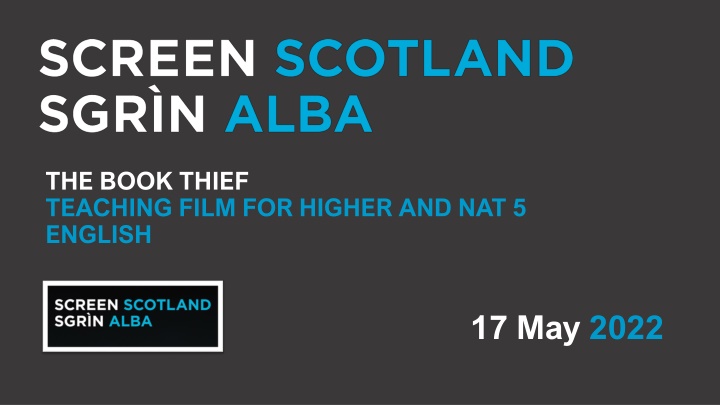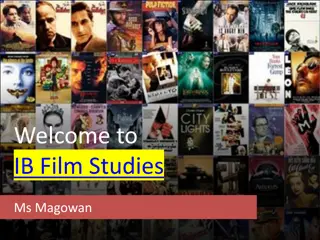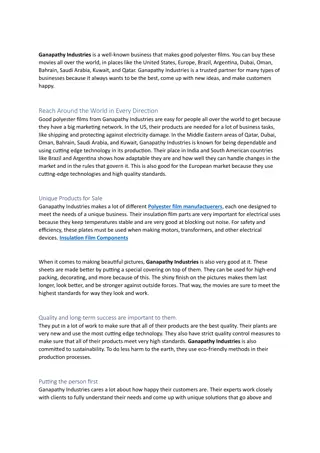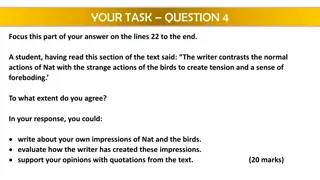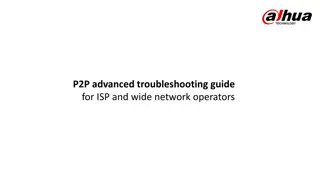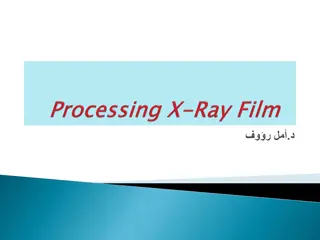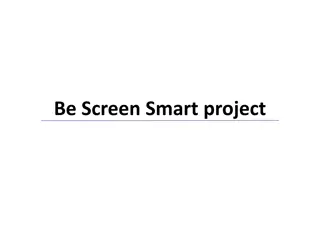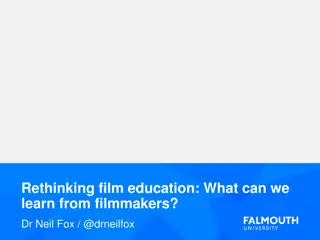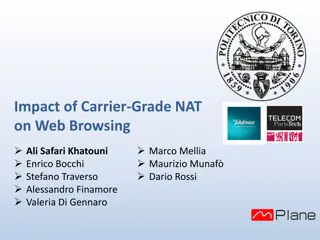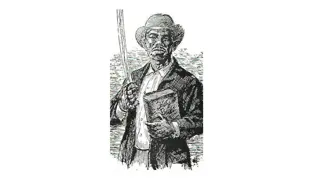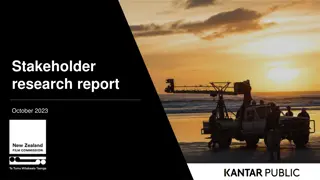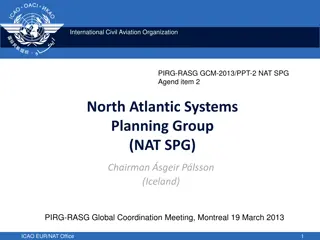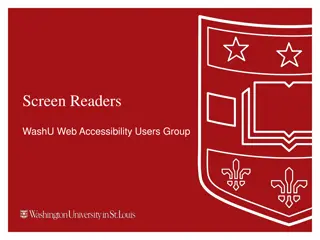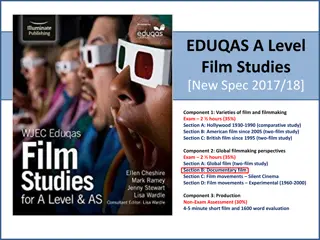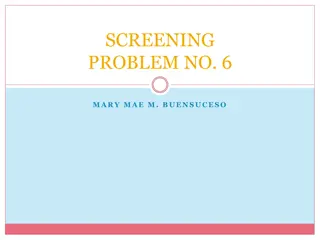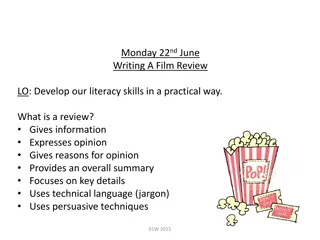Screen Education: Enhancing Learning Through Film for Higher and Nat 5 English
Explore the enriching experience of screen education through the lens of "The Book Thief" teaching film. Join education experts as they discuss the value of screen as an art form and its impact on learning, life, and work. Learn from experienced educators about integrating media studies into the curriculum and writing about films effectively. Discover how screen education can enhance education, develop skills, and shape a 21st-century perspective.
Download Presentation

Please find below an Image/Link to download the presentation.
The content on the website is provided AS IS for your information and personal use only. It may not be sold, licensed, or shared on other websites without obtaining consent from the author.If you encounter any issues during the download, it is possible that the publisher has removed the file from their server.
You are allowed to download the files provided on this website for personal or commercial use, subject to the condition that they are used lawfully. All files are the property of their respective owners.
The content on the website is provided AS IS for your information and personal use only. It may not be sold, licensed, or shared on other websites without obtaining consent from the author.
E N D
Presentation Transcript
THE BOOK THIEF TEACHING FILM FOR HIGHER AND NAT 5 ENGLISH 17 May 2022
Todays Schedule 4.30pm 4.30pm 4.35pm 4.35pm 4.50pm 4.50pm 5.05pm 5.05pm 5.20pm 5.20pm 5.30pm 5.30pm Fi Milligan-Rennie: Welcome and Introduction Euan McGrouther: Alloa Academy Nicola Daniel: Broughton High School Gail Robertson: Screen Scotland Questions and Feedback End
Our Aim SCREEN EDUCATION FOR ALL: SCREEN EDUCATION FOR ALL: The enrichment of the human experience and recognition of the purpose and value of screen as an art form. FOR LEARNING: FOR LEARNING: Enriching and expanding the experience of education; developing specific and transferrable skills. FOR LIFE: FOR LIFE: A 21st century approach to making sense of the world and our place in it. FOR WORK: FOR WORK: Education and training seamlessly link to develop capacities for work related to the screen industries.
Euan McGrouther Euan Euan McGrouther McGrouther qualified as an English teacher in 2008. As well as English he has spent a year as an ASN teacher and taught Psychology at Higher. He has taught in every High School in Clackmannanshire but has been permanently at Alloa Academy since 2017. Next year he will be undertaking the teaching of Media as a standalone subject as well as English.
Nicola Daniel Nicola Nicola Daniel Broughton High School in Edinburgh and author of two books on National 5 English. She is Lead Teacher of English for City of Edinburgh Council and an experienced SQA marker. Daniel is is Head of English and Media at
Gail Robertson Gail Gail Robertson Robertson is Screen Scotland s Screen Education Officer. She attended the University of Stirling where she received an Honours degree in Film & Media/English before training to become a Secondary Media and English teacher. Over 15 years she taught in Fife, Perth & Kinross, Edinburgh and London, gathering knowledge of a wide variety of educational approaches, curriculum needs and teaching strategies which are now utilised in her new role to ensure screen is at the centre of Scottish education.
Writing About Film Critical Essays
General Rules for Critical Essays
Text Choice: CUTS CHALLENGE: Obviously you want to choose a text that the class will engage with, but you still want to challenge them and expand their horizons. After all, if we took the same approach with literature, we d be unlikely to teach them Shakespeare or poetry they d rarely choose those! UNKNOWN: Choose a text that the class are unlikely to have seen before, so have no preconceptions about it. THEME: Texts with a clear theme such as LGBTQI+ or gender issues, racism, good vs evil or loss of innocence are a good starting point. SUITABLE: Choose one that is neither too lightweight nor too overwhelming. Learning how to critically analyse a screen text is challenging enough without being faced with a film that has no thematic heft or is too obtuse.
For Your Consideration: Alternative Film Choices Certificate: U / PG The Iron Giant (Brad Bird, 1999) The Kid Who Would Be King (Joe Cornish, 2019) Kubo and the Two Strings (Travis Knight, 2016) A League of Their Own (Penny Marshall, 1992) Ma Vie de Courgette (Claude Barras, 2016) Monster House (Gil Kenan, 2006) Spider-Man: Into the Spider-Verse (Bob Persichetti, Peter Ramsey & Rodney Rothman, 2018) Wadjda (Haifaa Al-Mansour, 2012) Whale Rider (Niki Caro, 2002) Certificate: 15 The Adventures of Priscilla, Queen of the Desert (Stephan Elliott, 1994) Attack the Block (Joe Cornish, 2011) Dead Man Walking (Tim Robbins, 1995) Eighth Grade (Bo Burnham, 2018) The Ice Storm (Ang Lee, 1997) The Mist (Frank Darabont, 2006) Once (John Carney, 2007) Pride (Matthew Warcus, 2014) Small Faces (Gillies Mackinnon, 1995) Train to Busan (Sang-ho Yeon, 2016) Die Welle (Dannis Gansel, 2008) Certificate: 12 Belleville Rendez-Vous (Sylvain Chomet, 2003) Hunt for the Wilderpeople (Taika Waititi, 2016) Love, Simon (Greg Berlanti, 2018) Me and Earl and the Dying Girl (Alfonso Gomez-Rejon, 2012) The Night of the Hunter (Charles Laughton, 1955) The Outsiders (Francis Ford Coppola, 1983) Persepolis (Vincent Paronnaud & Marjane Satrapi, 2007) Searching (Aneesh Chaganty, 2018) Sing Street (John Carney, 2016) Vampires vs. the Bronx (Oz Rodriguez, 2020) Certificate: 18 Battle Royale (Kinji Fukasaku, 2000) City of God (Fernando Meirelles & K tia Lund, 2002) Dead Man s Shoes (Shane Meadows, 2004) Do the Right Thing (Spike Lee, 1989) Heathers (Michael Lehmann, 1989) L.A. Confidential (Curtis Hanson, 1997) Nil By Mouth (Gary Oldman, 1997) Shallow Grave (Danny Boyle, 1994) The Thing (John Carpenter, 1982)
Using Evidence It s better to gather two or three techniques together as one piece of evidence (e.g. music, camera shot and lighting). Film meaning is created by the combination of techniques, not individual ones. Language Techniques: mise-en-sc ne (costume, props, set, lighting, actor position) dialogue and acting camerawork (framing, angles, movement) editing sound special effects A brief description of what is happening in the film at the moment techniques are used is vital. Context is everything: a close-up during a comedic moment will have a different meaning to a close-up used during a scary moment. Context + Technique (x Technique) = Effect.Ask yourself how the techniques work together to be effective in that particular moment.
Discussing Techniques Generally, there are some techniques that are easier for young people to grasp and write about, and also demand less time to teach the requisite skills. Mise-en-sc ne: Young people get to grips with this quickly, especially costume, colour and set. A word bank of adjectives can help them hugely with articulating their ideas. Dialogue and acting: Easy to understand, but don t necessarily lead to comments of great insight. Camerawork: There are a lot of camera shots, angles and movements to cover, but pupils often comment very well on their effect. Just have a camerawork guide handy! Editing: Requires a lot of teaching to get to the stage where pupils can confidently comment independently. Counting cuts to establish pace is an easy approach. Sound: Pupils do well here but, again, a word bank is invaluable for idea articulation. Special effects: Can comment on these in terms of establishing a setting or if discussing budget, but not always the most pertinent technique.
Scene Analysis Table Techniques: mise-en-sc ne (costume, props, set, lighting, actor position) camerawork editing sound special effects dialogue and acting Effect Context Technique(s) How do the techniques work together to create an effect in that moment? What is happening in that moment?
Effect Context Technique(s) How do the techniques work together to create an effect in that moment? What is happening in that moment?
PEEL Structure The same PEEL structure can be used for a screen text essay as any other critical essay, but with a few little tweaks PEEL Structure Sentence Starters I make a POINT about the task and say what techniques were used. Steven Spielberg uses ________, _______ and ______ effectively to convey... I describe the moment the techniques were used in as EVIDENCE. This can be seen in the moment/scene when I EXPLAIN what effect the techniques have and how they connect to my point. The use of ________ suggests while the _______ suggests The overall effect is I make a LINK between my explanation and the theme/my personal response. This links to the theme of ____ because I think this is effective because
ESSAY TASK: How does Steven Spielberg use film techniques to effectively create tension throughout Jaws ? TAPE Title/Text Author (Director) Plot Summary Essay Task INTRODUCTION POINT EVIDENCE EXPLANATION LINK I make a POINT about the task and say what techniques were used. I describe the moment the techniques were used in as EVIDENCE. I make a POINT about the task and say I EXPLAIN what effect the techniques have and how they connect to my point. I make a LINK between my explanation and the theme/my personal response. PEEL STRUCTURE Near the start of the film, Steven Spielberg uses ________, _______ and ______ effectively to create tension. This can be seen in the moment /scene when The use of ________ suggests while the _______ suggests This works together to create tension because This links to the theme of ______ because I think this is effective because SCENE 1: BEGINNING Around the middle of the film, Steven Spielberg uses ________, _______ and ______ effectively to create tension. This can be seen in the moment/ scene when The use of ________ suggests while the _______ suggests This works together to create tension because This links to the theme of ______ because I think this is effective because SCENE 2: MIDDLE At the end of the film, Steven Spielberg uses ________, _______ and ______ effectively to create tension. This can be seen in the moment/ scene when The use of ________ suggests while the _______ suggests This works together to create tension because This links to the theme of ______ because I think this is effective because SCENE 3: END TARA! Text/Title Author (Director) Response to text Answer to task End with style! CONCLUSION
Critical Essay BGE
Suggested Essay Tasks The same kinds of topics work for film as other texts: Trace the development of a character Describe the impact of setting on the text Trace a theme throughout the text Describe how the filmmaker creates an atmosphere/mood/tone Five-paragraph essay structure: the best approach is to choose evidence from the beginning, middle and end of the film for character and theme. You could also analyse a single scene from the film in depth, choosing three key moments of effective technique use to make up your five-paragraph essay.
Sample PEEL Response: BGE How does Steven Spielberg use film techniques to effectively create tension throughout Jaws ? Steven Spielberg uses colour, camerawork and lighting effectively to create tension in the scene with Alex Kinter s death. This can be seen in the opening moment when Alex asks his mum if he can go into the water again. The camera tracks Alex up from the water in a long shot and the editor doesn t cut away from him until he walks past Brody and the focus turns to him. Alex is wearing red swimming trunks. The use of the long tracking shot combined with the unbroken shot suggests that Alex will be important to the scene while the red trunks suggest that he could be in danger as red is the colour of blood. The overall effect creates tension because we know the shark is out there in the water and suspect that Alex could be its next victim. I think this is effective because the audience are like Brody, waiting for the next killing, and by drawing our attention to Alex using these techniques, we are become interested in his fate and are anxiously watching him, suspecting he will die and are tense, waiting for this to happen.
Critical Essay NQ
SQA National 5/Higher Task PART E FILM AND TELEVISION DRAMA Answers to questions on film and television drama* should refer to the text and to such relevant features as use of camera, key sequence, characterisation, mise-en- sc ne, editing, music/sound, special effects, plot, dialogue * TV drama includes a single play, a series or a serial. Make sure that you are comfortable with all these terms before studying the film. Study multiple techniques in three/four key scenes only. Do not attempt to whole chunks of the film it s too much! Choose key scenes from the beginning, middle and end of the film, and look for ones that address character, setting, plot, theme, etc. at once.
Sample PEEL Response: NQ Choose a film or television drama in which there is a particularly tense or dramatic sequence. Explain how the film or programme makers use media techniques to achieve this effect. (Higher: 2016) In The Mist , Frank Darabont uses sound, camerawork and editing in order to create tension in the scene where Dan runs into the supermarket right before it is enveloped by the mist. There are soft ambient sounds of everyone standing at the checkouts which is broken by the loud siren, leaving this moment otherwise almost completely silent. The editing here shows us a series of reaction shots of all the key characters. The silence is broken by Dan bursting in and shouting and his run down the street into the shop is filmed with handheld camerawork. The tension here is created by the contrast between the siren and the silence the absence of any other noise forces our focus on the siren (always an alarming noise) and makes it seems as though everyone is holding their breath, waiting for something, causing the audience to do the same. The editing adds to this effect as we are forced to wait, seeing only faces that reflect our own concern and nothing that may be happening outside making us curious and tense. We are shocked out of our poised tension by Dan s sudden arrival, with the handheld camera breaking the stillness of the moment and creating a sense of panic and chaos, causing the audience to feel as if they are running along with Dan and therefore share his fear. I think the use of silence here is particularly important in creating tension due to its unexpected nature. Horror films traditionally use the musical score as a method of inducing an atmosphere of fear and tension (for example, the iconic music used in Jaws and Psycho ). The audience is uneasy partly because they are aware of that lack of expected music on some level the unexpected silence is what is most disconcerting.
Past Exam Tasks: Nat 5 Particular scene or sequence 1. Choose a scene or sequence from a film or TV drama which shocks or surprises you in some way. By referring to appropriate techniques, show how in this scene or sequence the element of surprise is made effective. (2016) 2. Choose a scene or a sequence from a film or TV drama which has a powerful impact on the audience. By referring to appropriate techniques, explain how the director creates this impact. (2017) Character 1. Choose a film or TV drama in which there is a character about whom you have mixed feelings. Show why this character is important to the film or TV drama as a whole and by referring to appropriate techniques, explain how these mixed feelings are created. (2016) 2. Choose a film or TV drama which has a memorable character. By referring to appropriate techniques, explain how the director makes the character memorable throughout the film or TV drama. (2018)
Past Exam Tasks: Nat 5 Wild Cards! 1. Choose a film or TV drama which explores an important issue. By referring to appropriate techniques, explain how the director presents the issue in the film/TV drama as a whole. (2017) 2. Choose a scene or sequence from a film or TV drama in which setting is an important feature. By referring to appropriate techniques, explain how the director presents the setting in this scene or sequence. (2018) 3. Choose a scene or sequence from a film or TV drama in which an atmosphere of suspense or tension or horror is created. By referring to appropriate techniques, explain how this atmosphere is created. (2019) 4. Choose a film or TV drama which involves conflict. By referring to appropriate techniques, explain how this conflict is explored. (2019)
Past Exam Tasks: Higher Particular scene or sequence 1. Choose a film or television drama in which a particular scene or sequence contains tension or fear or surprise. With reference to appropriate techniques, explain how the film or programme makers create this effect, and discuss how this adds to your appreciation of the film or television drama as a whole. (2019) 2. Choose a film or television drama in which there is a sequence which is particularly moving or humorous or shocking. With reference to appropriate techniques, discuss how the film or programme makers succeed in engaging the viewer s emotions or reactions. (2018) 3. Choose a film or television drama in which the opening sequence is particularly effective in engaging the audience s interest. With reference to appropriate techniques, discuss how the film or programme makers succeed in engaging the audience s interest. (2017) 4. Choose a film or television drama in which there is a particularly tense or dramatic sequence. Explain how the film or programme makers use media techniques to achieve this effect. (2016)
Past Exam Tasks: Higher Character 1. Choose a film or television drama in which a main character either conforms to or challenges a stereotype. With reference to appropriate techniques, explain how the film or programme makers create this character, and discuss how this adds to your appreciation of the film or television drama as a whole. (2019) 2. Choose a film or television drama in which the viewer feels engaged with a character who is flawed or vulnerable. With reference to appropriate techniques, discuss how the film or programme makers succeed in creating engagement with the character, and how this adds to your appreciation of the film or television drama as a whole. (2018) 3. Choose a film or television drama in which the main character faces a significant moment of change. With reference to appropriate techniques, discuss how the film or programme makers convey the significance of this change. (2017) 4. Choose a film or television drama which concerns an individual or a group of characters facing a significant challenge. Explain how the film or programme makers use media techniques to convey the significance of this challenge. (2016)
Past Exam Tasks: Higher Wild Cards! 1. Choose a film or television drama whose soundtrack contrasts with or fits the scene(s) it accompanies. With reference to appropriate techniques, explain how the film or programme makers use of the soundtrack contributes to your appreciation of the film or television drama as a whole. (2019) 2. Choose a film or television drama in which setting in time and/or place is important to the development of the central concerns. With reference to appropriate techniques, discuss how the setting in time and/or place enhances your appreciation of the film or television drama as a whole. (2018) 3. Choose a film or television drama in which special effects make an important contribution to the impact of the film or television drama as a whole. With reference to appropriate techniques, discuss how the special effects are used to enhance your appreciation of the film or television drama as a whole. (2017) 4. Choose a film or television drama which is targeted at a specific audience. Explain how the film or programme makers use media techniques to target this audience. (2016)
Sharing is caring! Our teacher network on MS Teams via Glow is a great place to share resources and ask questions. I m always available! Screen Scotland: Screen Education | Microsoft Teams If the link doesn t work then just email me on Gail.Robertson@creativescotland.com No Glow email? Ask IT!
Want to learn more? Find short films, teaching resources, video tutorials and classroom activities: Screening Shorts Keep up-to-date with film education events/opportunities and chat to other educators: Screen Scotland: Screen Education | Microsoft Teams Learn more about our work and the role of film education: Screen Education | Screen Scotland Website Contact us directly: Fi.Milligan-Rennie@creativescotland.com Head of Education - Screen Gail.Robertson@creativescotland.com Screen Education Officer Follow us on Twitter: @ScreenEdScSc
Next months Tuesday Team Talk Cinema Paradiso: Cinemas and Schools Representatives from Scottish cinemas will share their Screen Education resources and opportunities to encourage both schools and young people to get the most our of their cinema-going experience. Tuesday 14 June 2022: 4.30pm-5.30pm
Padlet Feedback The Screen Education Team want their Tuesday Team Talks and everything they do to be led by those on the ground, so your feedback is really important to us. Please take the time to leave us some feedback on today s session on our Padlet: The Book Thief: Teaching Film for Higher and Nat 5 English (padlet.com) The link has also been posted in the meeting chat. Thank you!
